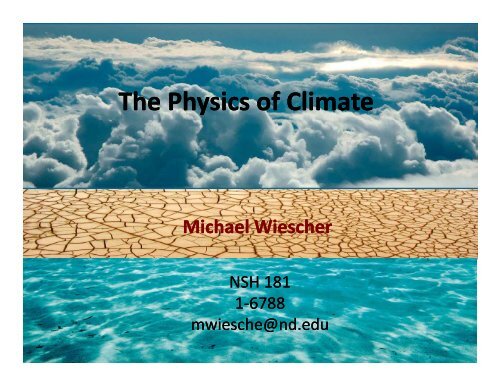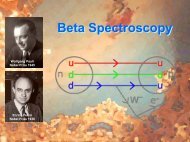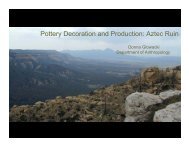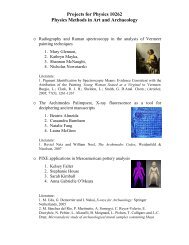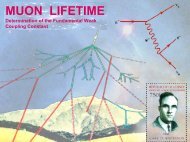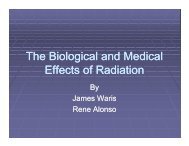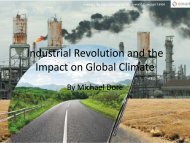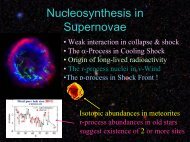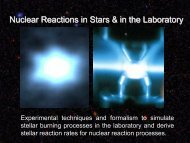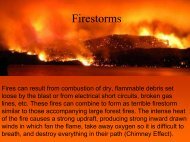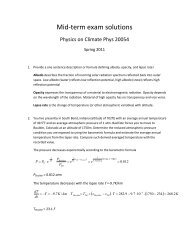Overview & Introduction
Overview & Introduction
Overview & Introduction
Create successful ePaper yourself
Turn your PDF publications into a flip-book with our unique Google optimized e-Paper software.
The Physics of Climate<br />
Michael Wiescher<br />
NSH 181<br />
1‐6788<br />
mwiesche@nd.edu
Additional speakers<br />
to be identified!<br />
Michael Wiescher<br />
Alex Long<br />
NSH 181<br />
NSH125b<br />
mwiesche@nd.edu<br />
along4@nd.edu<br />
http://isnap.nd.edu/Lectures/phys20054/
16 class participants<br />
p<br />
16 students & 16 projects<br />
1 David Thomas Brouch SC ROS2/SCBU<br />
2 Joseph Cruz Chavarria SC SCPP/ECON<br />
3 Jessica Ann DeLalio SC SCBU<br />
4 Michael Clark Dore SC SCBU<br />
5 Erin Margaret Doyle SC BIOS<br />
6 Andrew Schiller Ea SC SCPP<br />
7 Carlton John Fernandes SC SCBU<br />
8 Samantha Marie Genovese SC SCPP<br />
9 Jeffrey Charles Grant AL HIST/RU<br />
10 Savannah Meredith Hayes SC SCPP<br />
11 Patrick Michael Kozak SC SCBU<br />
12 Grayson Theodore Nowak SC PHYS<br />
13 Jessica Marie Pearson SC MATH/CHEM<br />
14 Mason Mary Perkins SC SCBU<br />
15 Michael Andrew Stecyk SC CHEM<br />
16 Zachary James Suriano SC ES
Drastic Climate Change
determined by :<br />
Cl d f ti<br />
energy absorption<br />
and emission<br />
Earth Climate<br />
Cloud formation,<br />
precipitation,<br />
and ice<br />
energy exchange<br />
through convective<br />
and radiative processes<br />
Ocean currents<br />
salinity and circulation
The Sun<br />
‣ Solar energy production<br />
‣ Energy emission<br />
‣ Sunspot activities<br />
‣ Long term evolution
‣ Energy absorption<br />
‣ Spectral absorption<br />
‣ Energy reflection<br />
‣ Energy loss<br />
December-January-February<br />
Earth’s energy budget<br />
June-July-August
Spectral absorption
Atmosphere<br />
‣ Thermal structure of atmosphere<br />
‣ Chemical composition of atmosphere<br />
‣ Chemistry of atmosphere<br />
‣ Greenhouse effect
Atmospheric Motion<br />
Origin and role of trade winds<br />
and jet cycles<br />
‣ Winds<br />
‣ Storms<br />
‣ Tornados
Condensation and Cloud Formation<br />
Cumulus clouds Cumulonibus clouds Cirrus clouds Stratus clouds
Chemistry of the atmosphere
Dust and Aerosols<br />
‣ Scattering of sun light<br />
‣ Absorption of energy<br />
‣ Chemical modification<br />
Historic evidence of sulfuric<br />
acid emission in Greenland<br />
and Antarctic ice cores<br />
20% natural sources<br />
Krakatau eruption 535-536 AD<br />
(volcanoes, hot sulphuric springs)<br />
80% anthropogenic sources<br />
(traffic, industrial pollution)<br />
Krakatau eruption 535-536 AD<br />
According to ancient records<br />
“Pustaka Raya Purwa” splitting<br />
Sumatra and Java!<br />
“There was a sign from the<br />
sun, the likes of which have<br />
never be seen or reported<br />
before. The sun became dark<br />
and the darkness lasted for 18<br />
months. Each day it shown for<br />
about 4 hours and still this<br />
light was only a feeble<br />
shadow.”<br />
John of Ephesus,<br />
Bishop of Syria
Volcanoes<br />
SO2 <br />
OH<br />
<br />
3 H<br />
2<br />
O <br />
H<br />
2<br />
SO4<br />
<br />
2<br />
H<br />
2<br />
O<br />
Conversion of ejected gaseous SO 2 into H 2 SO 4<br />
within six months<br />
Increase of stratosphere temperature by ~4 o ,<br />
decrease of temperature in hemisphere by ~0.2 o .
Ocean and Climate<br />
‣ Heat storage<br />
‣ Heat transport<br />
‣ Salinity<br />
‣ Hydrological cycle<br />
‣ Carbon cycle<br />
‣ Coupling ocean atmosphere
The Ocean Conveyor Belt
Ocean Currents<br />
Wind driven surface water currents<br />
Primary Forces<br />
‣ Solar heating<br />
‣ Wind<br />
‣ Gravity<br />
‣ Coriolis
Thermohaline circulation
Motors of the conveyor belt<br />
10 o C 3 o C<br />
Why does water with high salinity sink?<br />
Why is Atlantic salinity locally higher<br />
than the salinity of other oceans?<br />
Salinity in grams of salt<br />
per kg of water
Green House effect
Radiation Loss Imaging<br />
(Atmospheric Infra-Red Sounder AIRS)
The Carbon Cycle
The CO 2 Distribution<br />
2
The Milanković cycle –<br />
periodic natural variability<br />
Periodic warm and cool periods (ice<br />
ages) are explained by Milancović<br />
as collective effects of eccentricity,<br />
tilt and precession of earth’s axis!
Non‐periodic changes: the little ice age
Climate Records in Corals and Tree Rings<br />
Rings provide isotope & geochemical<br />
tracers of climate and human impact!<br />
Low salinity
Climate Records in Ice Cores<br />
Greenland Ice Core Project (GRIP) is a European funded initiative, which<br />
obtained a 3029m deep ice core (down to the bedrock) covering about 100,000<br />
years of climate past! Byrd Station refers to a research station established by the<br />
United States in Antarctica, the Byrd core was 2164m to the bedrock.<br />
Analysis of isotope ratios<br />
18<br />
O, 13 C etc<br />
Molecules<br />
SO 2<br />
CO 2<br />
Dust, particles, ashes
Climate History and paleoclimates
Climate Modeling
Climate change and<br />
climate engineering<br />
Climate change indicators<br />
Increase in greenhouse gas emission<br />
Increase in CO 2 concentration<br />
Global temperature increase<br />
Increase in heat waves and drought<br />
Change of precipitation rate<br />
Decline of arctic sea ice area<br />
Decline of high altitude glaciers<br />
Carbon sequestration<br />
CO 2 capture<br />
Ocean iron fertilization<br />
Solar radiation management<br />
Stratospheric sulfur aerosols<br />
Space mirrors<br />
Cloud reflectivity enhancements<br />
phytoplankton
Summary of class topics<br />
1. Solar radiation and the earth's energy budget<br />
2. Radiative and convective energy transfer<br />
3. Atmosphere and climate<br />
4. Clouds and aerosols<br />
5. Ocean and climate<br />
6. Greenhouse effect<br />
7. Ozone layer<br />
8. History of the earth climate<br />
9. Climate observations<br />
10. Climate models<br />
11. Climate change and climate engineering<br />
12. Consequences of climate change
Syllabus<br />
Class Prerequisites<br />
Math 10360 or 10560, & Physics concepts<br />
Class Content<br />
The course will focus on the description and analysis of the underlying physical and chemical processes<br />
that define the earth climate. The course will present a short overview of the climate history of our planet<br />
as indicated by modern techniques of climate recording.<br />
Climate depends critically on the overall energy budget, which is balanced by solar energy and the<br />
physical and chemical absorption and reflection processes in our oceans and atmosphere. The physics<br />
and chemistry of these processes and the impact on climate balance and weather patterns will be<br />
discussed. Global climate predictions require extensive mathematic modeling techniques. The underlying<br />
principles will be presented.<br />
The course will address questions related to observational evidence and possible consequences for<br />
natural and anthropogenic climate change. This part will be discussed in student presentations.
Class Projects<br />
Anthropogenic Climate Changes<br />
1. The economic consequences and opportunities of climate change<br />
2. Agriculture in Mesopotamia<br />
3. Abandonment of Maya Cities<br />
4. The large Midwest forest clearing<br />
5. Industrial revolution and the impact on global climate<br />
6. Nuclear testing in the 1950‐1960ies and the impact on the atmosphere<br />
7. Consequences of tropical deforestation<br />
8. Urban heat islands<br />
Natural Climate Changes<br />
9. Isotope Geology and the mapping of Earth’s climate<br />
10. Chicxulub and the death of dinosaurs<br />
11. Volcano eruptions and the consequences for global temperature<br />
12. Sahara in pre‐historic times<br />
13. The role of the Amazon jungle for global climate<br />
14. Noah’s Flood<br />
15. The little ice age and consequences for medieval life<br />
16. The expansion of the Sahel zone
Textbook & grade information<br />
Textbook<br />
F. W. Taylor, Elementary Climate Physics, Oxford University Press, 2005,<br />
ISBN 0 19 8567340<br />
Supplementary Reading Material<br />
J. Marshall & R. A. Plumb, Atmosphere, Ocean, and Climate Dynamics, , Elsevier, 2008,<br />
ISBN‐13 978‐0‐12‐558691‐7<br />
N. Mason & P. Hughes, <strong>Introduction</strong> to Environmental Physics, Taylor & Francis, 2002,<br />
ISBN 0 7484‐0765‐0<br />
J. P. Peixoto & A.H. Oort, Physics of Climate, AIP & Springer Verlag, 1992,<br />
ISBN 0 88318‐712‐4<br />
K. E. Trenberth, Climate System Modeling, Cambridge University Press, reprint 2009,<br />
ISBN 978‐0‐521‐12837‐7<br />
Class Grades<br />
Weekly quizzes 10%; Homework 25%; Midterm Exam 30%;<br />
2 class room group presentations each 15%; participation 5%


